Every year, millions of Americans either buy new houses or remodel their existing ones, all in an attempt to get their dream homes. When styling these homes, people who love culture and history tend to use art and antiques to great effect to give their homes a classical feel.
However, even with all those vintage amenities, nothing compares to buying and remodeling a historic house. In the United States, there are only about 90,000 listed historic properties. An old house is not necessarily a historic house.
According to the National Register of Historic Places, a historic house must be at least 50 years old. In addition, it must have some cultural or architectural significance or have been the residence of a historically significant person.
Owning a historic house comes with a few benefits, including:
- Regulations and historic significance protect your property’s value.
- Historic homeowners receive tax incentives and deductions.
- Remodeling historic homes is good for the environment as fewer resources are needed in comparison to building a new house.
- In historic districts, you get to live with people who love history as much as you do.
In addition to the alluring beauty and charm that comes with a historic house, you will also be investing in preserving history itself. However, historic home remodeling is no easy feat. Here are some tips to help you out:
1. Find out about remodeling restrictions and permits
With historic homes, the first thing you should do is find out whether they are in a historic overlay district. In some jurisdictions, you may need approval for remodeling the exterior of the house. These restrictions are put in place to ensure that your luxury home remodeling does not erode the historical significance of the real estate.
2. Consult with a professional
There are unique challenges that come with remodeling older houses. As such, it is vital that you work with home remodeling consulting services. Their expertise and experience will help you determine how the house was built and identify trouble spots before renovation begins.
3. Disaster-proof your house
As building techniques and materials have improved over the years, houses built today are stronger. The wear and tear a historic house has endured over the decades make them even less structurally sound.
By working with a luxury custom home builder, you will be able to determine if the house can survive a disaster. Disaster proofing may involve retouching the foundation and adding more support columns.
4. Update the technology
The main area of concern here is the wiring. The house may have electricity, but it may not have been geared for 21st century electrical needs. As such, you should have the wiring redone to ensure all your gadgets can be powered without causing a safety hazard.
Are you aware that making historic houses energy efficient can be up to eight times as efficient as making minor improvements to modern homes? As you redo the wiring, consider making your house energy efficient. As a history enthusiast, it’s also safe to assume you’re keen on preserving the world for future generations.
5. Preserve as much of the history as you can
Of course, you will have to make some 21st-century style adjustments to your house to ensure your lifestyle is not compromised. However, the whole idea of living in a historic home is the desire to be close to history.
As you make adjustments, ensure that you preserve all the essential features that give the house its distinctive historic appeal. As you do this, you will preserve the unique stories of the people who lived there as well as the town’s history and heritage.
If you love history and appreciate the vintage look, remodeling a historic house is a perfect way to satisfy your passion. In addition to the wealth of culture, charm, and heritage, such properties are also full of exotic beauty.
To ensure that your whole home remodeling retains the history and heritage of your house, work with experienced luxury custom home builders. Contact GuyCo Homes and Remodeling today to start your historic home remodeling journey.


